No Boundaries in Babb
Two families, the Thronsons and the Burnses, have run this town’s business district for nearly a century. There’s a reason they never left.
By Myers Reece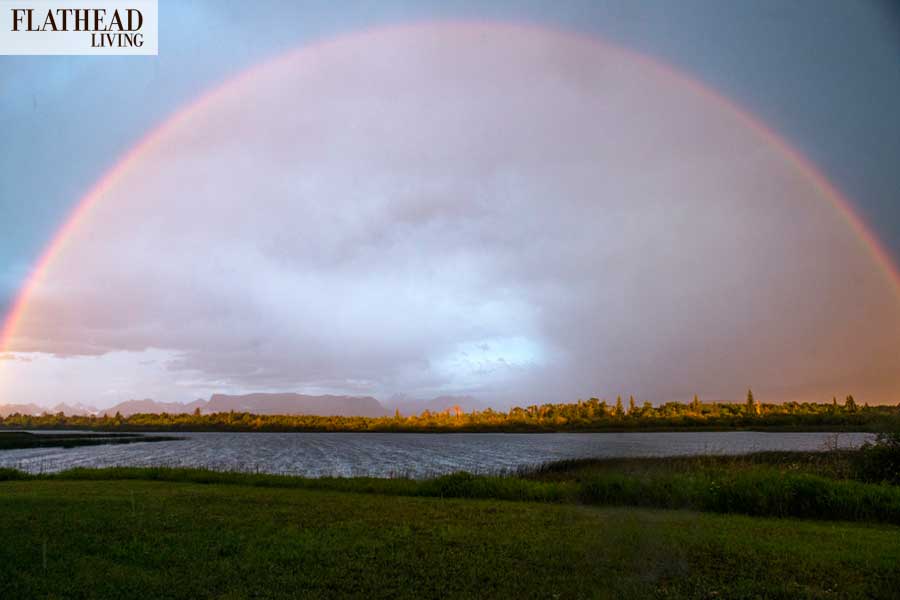
Editor’s Note: This is one of the stories featured in the fall edition of Flathead Living magazine. Pick up a free copy on newsstands throughout the valley.
Nobody has drawn boundaries here, but it wouldn’t be hard to do. You only need to draw one. This is the Thronson side of town. That’s the Burns side. Case closed. There are no other sides, nor have there really ever been.
Dating back to around the Great Depression, with only scattered exceptions, two families have owned every business in this small ranching community on the western edge of the Blackfeet Indian Reservation near Glacier National Park. Babb has fewer than 200 residents, though perhaps a couple hundred more live in the vicinity, along an isolated stretch of windswept Highway 89 just south of Canada. Summer brings thousands of tourists. At one point or another, almost all of them, locals and tourists alike, show up at the doorstep of the Thronsons and Burnses.
Bob Burns, a Blackfoot tribal member, owns the Cattle Baron Supper Club, Bunkhouse Café, and Babb Bar, once called the second rowdiest bar in the U.S. by Playboy magazine, while his son runs Charlie’s Place bar across the highway. The land has been in his family since the beginning of the 20th century. Burns, who turned 71 in August, is a little younger than the land, but he’s still “been here longer than electricity.”
A couple hundred yards north, Mike and Debbie Thronson own Thronson’s General Store and Motel, Glacier’s Edge Café, the gas station and a seasonal antique shop. Mike’s great-grandparents opened the original store in 1920 and now his two daughters, 23-year-old Katrina and 21-year-old Cassy, are learning the ropes to become the fifth generation to run the family businesses.
That’s the extent of the business district. There’s a K-6 school just north, as well as some restaurants several miles out of town, but between the two Babb road signs it’s all Thronsons and Burnses.
“The only thing we don’t have is the post office,” Burns says. “Can’t buy that one. That’s the government’s.”
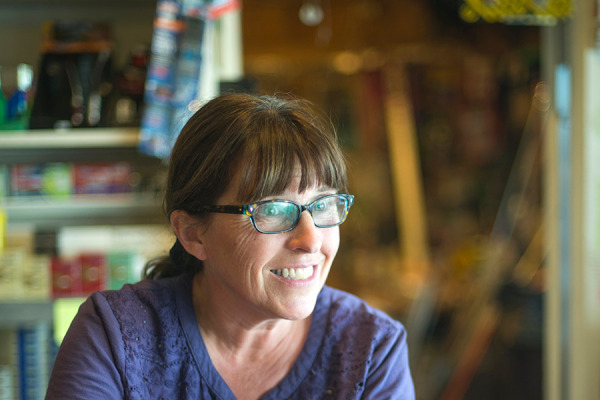
But if you can’t own it, you can run it. Most of the town’s postmasters have historically been Thronsons, and the post office once resided inside their general store before moving to its own location. These days, however, the Thronsons have more than enough responsibilities in Babb without overseeing everyone’s mail, too.
While it’s not uncommon for a rural town to feel like a time capsule, the cycle of business turnover and family migration typically ensures compounding degrees of change. In Babb, however, this cycle has been effectively absent. No changes in name. No changes in values. Just a few paint jobs and a couple new buildings.
The Internet arrived, stubbornly, and a visitor might even get a bar or two of cell phone reception – Verizon only – but if you ignore the modern cars outside Thronson’s store and the 21st century goods inside, you don’t need an overly active imagination to envision yourself in the 1920s. The original cash register rests behind the counter, small-town banter fills the air instead of background music, and an 86-year-old epiphyllum orchid cactus hangs from a planter in the front window, still clinging to life. Surrounding the store, near-century-old laborer cabins stand untouched.
“It’s kind of like stepping back in time,” Katrina says. “We like it this way.”
Following the passage of the Reclamation Act of 1902, the U.S. federal government launched an ambitious irrigation project along the St. Mary River basin in the area of modern-day Babb, eight years before Glacier National Park was established. The lengthy undertaking would ultimately construct dams on Swiftcurrent Creek and below Lower St. Mary Lake to divert and store water, as well as a canal to transport water to the Milk River basin for agricultural use on the semiarid Hi-Line plains. The Swiftcurrent dam created Lake Sherburne.
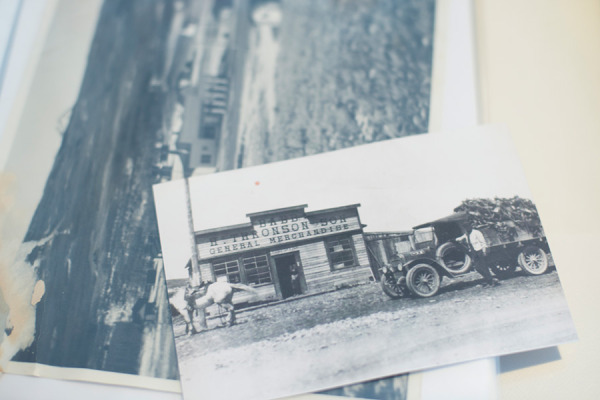
To accommodate the large work crews, a post office was established in 1905, named after chief project engineer Cyrus C. Babb. A year later, frontier merchant J.H. Sherburne opened a trading post, according to a written historical account by Joe Sherburne. An act of Congress in 1908 formally identified Babb as a town site, along with Browning.
Hans and Hannah Thronson, a married Norwegian immigrant couple, arrived in Babb with their two sons at the tail end of World War I. Like many others at the time, they were drawn westward by the expansion of the Great Northern Railway. They worked odd jobs, such as cutting ice from nearby frozen lakes and selling it for refrigeration, before opening a general store in 1920. Four years later, they moved Babb H. Thronson & Son General Merchandise to the location where it still stands today.
Sherburne cites the Thronson mercantile as one of two general stores in those early years, though Babb’s two-shop arrangement would eventually dwindle to one. In addition to the store, the Thronson family opened the motel in the ‘50s and the café and gas station in the ‘60s. The antique store, run each summer by Debbie’s sister, is located in a building that once housed the earliest Thronsons, and it’s even older than the mercantile.
But once the Thronsons moved into a home attached to the back of the general store, they never moved again. Every Thronson to run the business has lived in that same house. The home has grown with renovations, but some original features such as the fireplace remain intact. Carved into the fireplace’s brickwork above the pit are the initials of two of the earliest Thronsons. While that relic is engraved in stone, another is planted in soil: the 86-year-old cactus, greeting customers at the front door as it has for nearly a century.
Katrina and Cassy proudly point out the fireplace and cactus as two enduring symbols of family heritage. The young women know they are the ones who will decide whether those symbols continue to endure in their family name. They are the ones who will be responsible for pipes bursting in arctic winters amid 80-mile-per-hour winds, for making ends meet with brutally short business seasons, for keeping long-held traditions alive.
Barely into their 20s, they seem up to the task.
“We’re excited for it,” Katrina says. “This is what we’ve always known.”
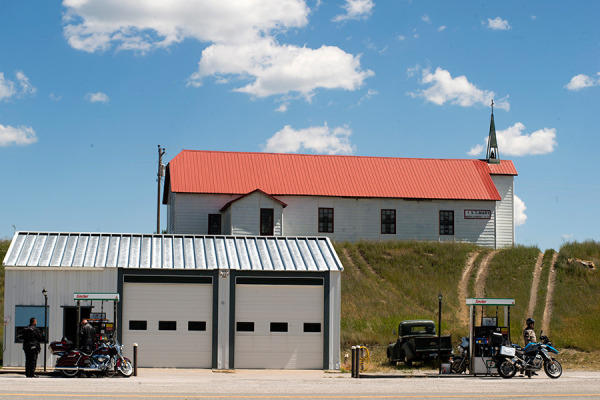
Mike and Debbie took over the family business in 1989. Within the next few years, Katrina and Cassy were born. The sisters attended school 30 miles north in Cardston, Alberta. Families in and around Babb have the option of sending their kids to the Babb K-6 elementary, and Browning school system after that, or to Cardston.
Mike and Debbie would drive the girls to a bus station at the Canadian border, about halfway between Babb and Cardston, where a bus would pick them up and transport them the rest of the way. That was assuming they could first dig their way out of Babb’s wicked and frequent snowdrifts.
The Thronsons learned to divvy up the multi-faceted responsibilities of running several businesses. Debbie assumed the boss role, overseeing finances and daily management. Mike, who works for U.S. Customs and Border Protection, became the chief maintenance man, attending to projects when he had spare time away from his day job. The girls chipped in where they could, their duties growing as they grew.
Today, at least 15 employees work for the Thronsons during peak season, living in cabins behind the store and motel. Employees speak highly of the laid-back environment, fostered innately by the secluded geography and consciously by the congenial Thronsons, who like to see everybody enjoying themselves while getting work done.
“We’ve got our own little Thronsons’ community here,” Katrina says.
The family no longer lives year round in Babb, shutting down business for the coldest months, except for the unmanned 24-hour gas pump, and spending part of their time in the Flathead. But the responsibilities don’t go into hibernation, rearing their head in even more unpleasant ways when the temperatures dive below freezing.
Katrina and Cassy understand that frozen pipes and snowdrifts are part of the deal, requiring mid-winter trips on icy roads from Kalispell. They know that the logistics of operating businesses in a remote pocket of a rural state aren’t getting easier. For one, distribution trucks make fewer trips. The Thronsons take turns hauling trailers to Kalispell and Great Falls to pick up supplies.
But they also know it’s worth it when a father and son visiting the area are able to find a fishing rod and tackle at their store, when a local rancher doesn’t have to drive far from home to get fresh produce, when a community depends on you and you’re up for the challenge. They know how hard it is to walk away from 90 years of tradition.
“I hope they really do want to do it,” Debbie says. “It means a lot.”
Bob Burns was born on the Blackfeet Reservation in 1943. He remembers the collective excitement when electricity brought the wonder of television into reservation living rooms, though as he grew older TV interested him far less than the land, as a source of both economic bounty and family pride.
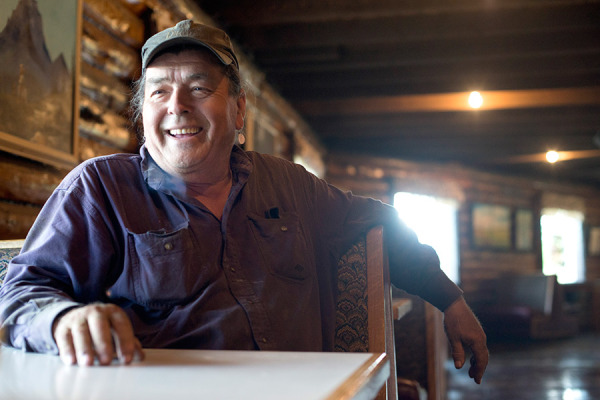
Burns says his grandmother, beginning in 1900, originally owned the land on which his businesses sit today, at the intersection of Highway 89 and Route 3 leading to Many Glacier inside the park. His family opened a restaurant there, which was converted into a bar in 1954 after the reservation’s alcohol prohibition ended. Burns purchased it from his father in 1974.
Throughout the 1970s and early ‘80s, the Babb Bar established a reputation as a wild, rough-and-tumble tavern where tough locals, both native and not, tested their alcohol tolerance, and often their streetfighting prowess, against bikers, seasonal park employees and any other free spirit who was up for the test. Sometimes Burns kicked them out. Sometimes he joined them.
Burns, whose chiseled ranching hands and big-shouldered bear frame suggest he could still hold his own in a tussle, refers to barfighting with a much gentler euphemism: “rolling around in the gravel.”
“Back then, you know, a couple guys might get a little wild and go outside and roll around in the gravel for a bit,” he says. “Then they’d go inside, get a drink, and maybe go back out and do it again. It wasn’t too big of a deal. That’s just how it was.”
In 1986, Burns decided to open a steakhouse, the Cattle Baron Supper Club, to transition away from the rowdy bar days as he grew too old for “rolling around in the gravel with the kids.”
“I figured I’d feed them a big steak instead,” he says.
He was instrumental in every phase of constructing the impressive high-ceilinged steakhouse: “from the forest to what you see.” With a background in construction, in addition to farming and ranching, he logged the timber himself, processed it at his own sawmill and then built the restaurant to his own tastes. The murals and artwork adorning the walls reflect his deep pride in his Blackfoot heritage.
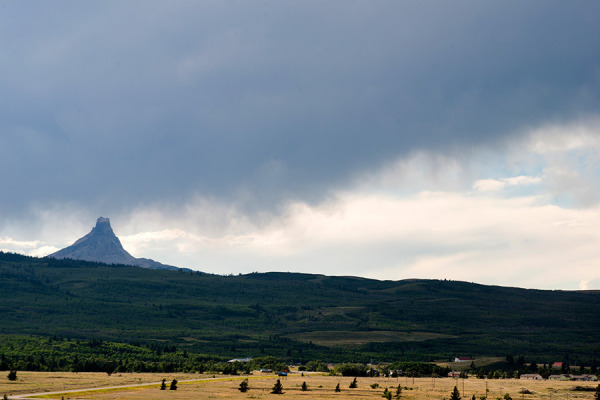
Though his hand-built eatery has treated him well, Burns still recalls the pre-steakhouse days with wide-eyed nostalgia, as if talking about a strange but wonderful dream. On a crazy day back then, the bar might make up to $8,000 serving 25-cent beer and 75-cent drinks, dizzying math by any standard of alcohol consumption.
Burns recounts a story about a couple who had come to check out the bar to gauge the veracity of its reputation. They asked Burns, “Is it really that wild?”
“About that time a guy drove his Harley right through the bar,” Burns says. “Then a woman rode her horse through. And a little later, a guy packed a little bear cub in.”
“Those days were probably the most fun I’ve ever had in my life. You wanted to be here because you never knew what was going to happen.”
Nowadays, Burns’ businesses have more of a reputation for mouth-watering steaks and home-cooked food than barfights and bear cubs. The Cattle Baron’s steaks have gained recognition in national publications such as New York Magazine and Maxim, and the restaurant is both family-friendly and truly family-run. With 60 grandchildren, Burns says he has “a hell of workforce to choose from.”
When a visitor asked how many of those 60 work for him, he thought hard and arrived at a total of 15. He checked with his manager to confirm.
“Fifteen?” the manager said. “No, it’s about 30-35.”
“Jesus Christ!” Burns hooted. “I didn’t know I had so many!”
Someone in this big family will likely take over the business, but not yet. Even though he’s 71 and his wife, Charlene, is turning 65, Burns doesn’t seem to believe in retirement. In addition to his active role in the restaurants and bar, he still runs cattle and works the land.
“God gave you a body, so you better use it,” he says. “If you just let it sit, you die.”
Leaning back in a Cattle Baron booth in late July, Burns sat stoically as his daughter-in-law braided his hair to keep it out of his eyes when he returned that evening to the hayfields. One of his younger grandchildren, perhaps a potential heir to the throne much further in the future, complained of a toothache. Neither Burns nor the kid knew what was causing it, but they both knew where to look for the remedy.
“I’m going to Thronson’s,” the boy said.
And that’s why there are no boundaries in Babb, figurative or literal. When you’ve had the same neighbors for a century, the only lines worth drawing are the ones that connect, not divide, like the well-worn path leading through a grassy field from the Cattle Baron Supper Club straight to the porch of Thronson’s General Store. No matter how brutal the winter is, when the snow melts, that path will always be there.